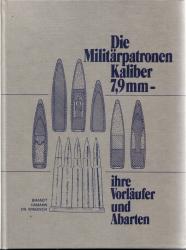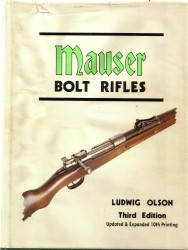 |
History and Development of the 7.9x57mm Cartridge |  |
|
|
|
|
Firearms Technical Trivia, July 2001:
 |
History and Development of the 7.9x57mm Cartridge |  |
INTRODUCTION
If there is one cartridge which
can be said to have set the pattern for military and sporting rifle cartridges
during the twentieth century, and from which most other cartridges can
be said to be derivative, it is the German 7.9x57mm cartridge, also known
as the 8mm Mauser. During its heyday, the 7.9x57mm cartridge
was adopted by more than twenty nations, and derivative cartridges by countless
others. To this day its performance remains the benchmark by which
all other full-power battle rifle cartridges are measured.
Commission Model 88 Cartridge
| Case Length: 57mm | Bullet Type: Jacketed round nose | Bullet Weight: 227 grains | Powder Charge Weight: 40.6 grains |
| Cartridge Length Overall: 3.25" | Bullet Length: 1.23" | Bullet Jacket Material: Cupro-nickel clad steel | Muzzle Velocity: 2,034 feet per second from 29.13" barrel |
| Cartridge Weight: 432 grains | Bullet Diameter: .318" | Powder Type: Flake Nitrocellulose | Maximum Pressure: 31,284 lbs/inch2 |
| The Commission Model 88 cartridge, designed by the German Infantry Commission at Spandau Arsenal, set the pattern for the entire series of Mauser smokeless powder rifle cartridges, both military and sporting. The Commission Model 88 cartridge, adopted for the German Commission Model 88 rifle, was a rimless cartridge with a very slight body taper. The rimless design, unique among military rifle cartridges of the day, made for a more compact cartridge that was better adapted for use in stripper and en bloc clips, as well as improved feeding characteristics from box magazines. There were design trade offs for the rimless cartridge's improved reliability: For one, the case head was made |
Image Credit: Brandt, Hamann, Windisch, Die Militar Patronen Kaliber 7.9mm - ihre Vorlaufer und Abarten, (Journal-Verlag Schwend GmbH, Schwabisch Hall, 1981) Page 31 |
Image Credit: Brandt, Hamann, Windisch, Die Militar Patronen Kaliber 7.9mm - ihre Vorlaufer und Abarten, (Journal-Verlag Schwend GmbH, Schwabisch Hall, 1981) Page 16 |
The case's
slight taper allowed for the use of a heavy propellant charge without the
need for an extremely long case. The taper of the case shoulder was
a compromise between the sharp angle necessary for a positive headspace
indexing and the gentle slope that made for ease of manufacture.
The case's neck was made no longer than absolutely necessary for a firm
grip on the bullet. The case's overall length was 57mm, and as a
result the cartridge attained unofficial recognition as the 7.9x57mm.
At the same time as military production commenced, the cartridge was also
offered commercially as both the 8mm Mauser and the 8x57mm Mauser.
Markings on case heads of military Model 88 cartridges included the year
and month of production as well as a letter code indicating the manufacturer.
The Model 88 cartridge took advantage of all the relevant technological advances of the day. One of these was the metal jacketed bullet developed in 1874 by Lieutenant Colonel Bode of the Prussian Army and improved by Colonel Rubin of the Swiss Army. The jacketed bullet made the use of smokeless propellants practical and economical. It allowed for proper engraving and rotation of the bullet under heavy gas pressure thrust without stripping of the bearing surface and resultant fouling of the bore. The Model 88 cartridge had a 227 grain bullet that was jacketed with cupro-nickel clad mild steel. The round-nosed bullet had a very long bearing surface, with an inset base. Mindful of the problems of powder and jacketing fouling caused by excessive engraving resistance, the bullet's diameter, .318", was about .003" smaller than the diameter of the bore. As a result, excessive engraving and pressure was avoided. Recognizing that this size disparity might have a detrimental effect on accuracy if the rifling was too shallowly engraved, the convex base of the lead core was joined by the turned in edges of the bullet jacket. As a result, the bullet's base expanded when the cartridge was fired to provide an effective gas seal. The bullet's great length made for excellent sectional density and penetration. The Model 88 cartridge's propellant was nitrocellulose in the form of rectangular flakes, as used in the French 8mm Lebel cartridge. Flake propellant was to become a trademark of Mauser smokeless powder cartridges. Although the |
7.9mm S Cartridge
| Case Length: 57mm | Bullet Type: Jacketed pointed nose | Bullet Weight: 154 grains | Powder Charge Weight: 49.3 grains |
| Cartridge Length Overall: 3.17" | Bullet Length: 1.11" | Bullet Jacket Material: Gilding-metal clad steel | Muzzle Velocity: 2,936 feet per second from 29.13" barrel |
| Cartridge Weight: 367 grains | Bullet Diameter: .323" | Powder Type: Flake Nitrocellulose | Maximum Pressure: 44,082 lbs/inch2 |
| The S (for Spitzgeschoss, or "pointed bullet") cartridge with its 154 grain pointed was adopted by Germany in 1903, with initial issues taking place on October 1, 1905. The new cartridge had significantly lighter bullet coupled with a much heavier powder charge. Consequently the muzzle velocity was far greater than that obtained with the Model 88 cartridge. When coupled with the lower air resistance offered by the pointed bullet, the S cartridge offered a significantly flatter trajectory than the Model 88. As a result, rifles chambered for the S cartridge had sights calibrated differently than those for the Model 88. |
Image Credit: Brandt, Hamann, Windisch, Die Militar Patronen Kaliber 7.9mm - ihre Vorlaufer und Abarten, (Journal-Verlag Schwend GmbH, Schwabisch Hall, 1981) Page 37 |
The S cartridge also used a projectile
of .323" in diameter, .005" larger than that of the Model 88. This
required a case neck of somewhat larger diameter than that of the Model
88. In point of fact, this was the only dimension in which the S cartridge
case differed from that of the Model 88. As with the Model 88, the
S cartridge used flake type propellant, but the S cartridge's propellant
was improved with the addition of a deterrent surface coating which improved
the velocity to pressure relationship by means of a more progressive propellant
ignition. The deterrent coating, a urea derivative known as Centralite,
was named after the place of its development the Centralstelle fur wissenschaftlich-technische
Untersuchungen - the
Central Office for Scientific Technical
Research - at Neubabelsburg. This organization was part of the armsmaking
conglomerate Deutsche Waffen-und-Munitionsfabrken (DWM), and apparently
collaborated with the German government on some of its research projects.
DuPont, the American chemical giant, later used the Centralite patents
when developing their line of smokeless propellants.
During World War One, raw materials
for making brass cases became scarce, and from 1916 onward, many S cartridge
cases were made from mild steel and plated with copper internally to prevent
rusting. The case heads were marked with the month and year of production
as well as a letter to indicate the manufacture. The marking "S67"
was also used to indicate a brass case, and was commonly stamped on S cartridges
produced during World War One.
Left, without cannelure, Right, with cannelure Image Credit: Brandt, Hamann, Windisch, Die Militar Patronen Kaliber 7.9mm - ihre Vorlaufer und Abarten, (Journal-Verlag Schwend GmbH, Schwabisch Hall, 1981) Page 20 |
The base of the S bullet was slightly concave as an aid to bore obturation. The initial production run of S bullets were made without cannelures. From around 1916 onward, bullets were manufactured with a deep cannelure. This enabled a more secure crimp, which improved cartridge durability for use in machine guns. The bearing surface at the rear of the cannelure was .323" in diameter, while that forward of the cannelure was .321". Both were comparatively short, which helped to ease the bullet's entry into the rifling. |
7.9mm sS Cartridge
| Case Length: 57mm | Bullet Type: Jacketed pointed nose, boat tail | Bullet Weight: 198 grains | Powder Charge Weight: 43.9 grains |
| Cartridge Length Overall: 3.17" | Bullet Length: 1.38" | Bullet Jacket Material: Gilding-metal clad steel | Muzzle Velocity: 2,575 feet per second from 29.13" barrel, 2,476 feet per second from 23.62" barrel |
| Cartridge Weight: 412 grains | Bullet Diameter: .323" | Powder Type: Flake Nitrocellulose | Maximum Pressure: 46,926 lbs/inch2 |
| During the
First World War, it was discovered, much to the Germans' chagrin, that
the S cartridge did not have the range of the French 8mm Balle D cartridge,
and was therefore inferior for long range machine gun fire. To overcome
this shortcoming, the Germans developed a new 7.9mm cartridge with a 198
grain bullet of spitzer boattail design. As the new cartridge had
a heavier bullet than the S cartridge, it was designated the sS (schweres
Spitzgeschoss - heavy pointed bullet) cartridge.
Since the sS bullet weighed considerably more than the S bullet, it had a considerably lower muzzle velocity. However, the sS bullet's |
Image Credit: Brandt, Hamann, Windisch, Die Militar Patronen Kaliber 7.9mm - ihre Vorlaufer und Abarten, (Journal-Verlag Schwend GmbH, Schwabisch Hall, 1981) Page 71 |
Image Credit: Brandt, Hamann, Windisch, Die Militar Patronen Kaliber 7.9mm - ihre Vorlaufer und Abarten, (Journal-Verlag Schwend GmbH, Schwabisch Hall, 1981) Page 58 |
Visually, it is easy to recognize the sS cartridge from the S cartridge. The sS cartridge has a green primer annulus as opposed to the S cartridge's black annulus, and the gradual taper of the bullet's ogive. During the early 1930's, the case markings on 7.9mm cartridges were changed by replacing the month of production with a lot number and the brass case indication symbol "S67" with "S*". In a few instances the manufacturer was still indicated by an initial, but more generally by a |
7.9mm SmE
and SmE (lang) Cartridges
SmE
| Case Length: 57mm | Bullet Type: Jacketed pointed nose, boat tail | Bullet Weight: 178 grains | Powder Charge Weight: 43.2 grains | |
| Cartridge Length Overall: 3.17" | Bullet Length: 1.45" | Bullet Jacket Material: Gilding-metal clad or zinc plated steel | Muzzle Velocity: 2,526 feet per second from 23.62" barrel | |
| Cartridge Weight: 394 grains | Bullet Diameter: .323" | Powder Type: Flake Nitrocellulose | ||
Image Credit: Brandt, Hamann, Windisch, Die Militar Patronen Kaliber 7.9mm - ihre Vorlaufer und Abarten, (Journal-Verlag Schwend GmbH, Schwabisch Hall, 1981) Page 89 |
||||
SmE (lang)
| Case Length: 57mm | Bullet Type: Jacketed pointed nose, boat tail | Bullet Weight: 162 grains | Powder Charge Weight: 42.4 grains | |
| Cartridge Length Overall: 3.17" | Bullet Length: 1.57" | Bullet Jacket Material: Gilding-metal clad or zinc plated steel | Muzzle Velocity: 2,460 feet per second from 23.62" barrel | |
| Cartridge Weight: 385 grains | Bullet Diameter: .323" | Powder Type: Flake Nitrocellulose | ||
Image Credit: Brandt, Hamann, Windisch, Die Militar Patronen Kaliber 7.9mm - ihre Vorlaufer und Abarten, (Journal-Verlag Schwend GmbH, Schwabisch Hall, 1981) Page 111 |
||||
Lead shortages during the Second
World War led the Germans to develop 7.9mm ball cartridges with mild steel
bullet cores. These cartridges were known as the SmE (Spitzgeschoss
mit Eisenkern - Pointed bullet with iron core) and SmE (lang) (pointed
bullet with long iron core). Both had a lead sleeve between the core
and the jacket to ease the bullet's passage through the bore, and the SmE
bullet had a lead filler inside the point. The SmE (lang) had a longer
steel core than the SmE. Instead of bullet jackets made from mild
steel sandwiched between layer of gilding metal, steel jackets thinly plated
with gilding metal or zinc were used in order to save copper.
| Steel cases
used in the SmE and SmE (lang) had a bonderized (a form of phosphating)
finish and were coated with clear lacquer as a rust preventative.
There was also a thin layer of wax on the outer surface to help prevent
corrosion and to ease extraction. Additionally, copper plated steel
cases were also used. Copper plated case have a Roman numeral marking,
while those with a lacquer coating were marked "St" or "St+". Case
walls toward the base of "St" marked steel cases were slightly thicker
than those of brass cases. The "St+" brass case had the same wall
thickness and capacity as a brass case.
Identification of the SmE cartridge was by means of a blue primer annulus. The primer of the SmE cartridge was coated with a clear lacquer. These rounds were generally loaded with the 30/40 non-corrosive primer having a zinc-plated steel cup. This primer replaced the Model 88 corrosive primer which had been standard since the inception of the Model 88 cartridge. Many of the 7.9mm steel cases produced during the Second World War have only one flash hole, which was adjacent to the anvil and slightly off center. The single hole was larger in diameter than the twin holes, and aided in manufacture by reducing breakage of flash hole drill bits. There was also a variety of special purpose 7.9mm military cartridges. These included blanks with a red, hollow wooden bullet, a dummy round, armor piercing, tracer, and incendiary cartridges. Additionally, there were certain |
(From left - Types A, B and C) Image Credit: Brandt, Hamann, Windisch, Die Militar Patronen Kaliber 7.9mm - ihre Vorlaufer und Abarten, (Journal-Verlag Schwend GmbH, Schwabisch Hall, 1981) Page 86 |
CONCLUSION
The 7.9mm military cartridge is
arguably the most significant cartridge of the 20th century, being the
direct ancestor of such military stalwarts as the 7x57mm, the .30-06,
the 7.5x55mm, and the 7.5x54mm. Indeed, a good case can be made for
tracing the design characteristics of the 7.62mm NATO back to the original
S cartridge. Despite this impressive lineage, and the fact that there
is a tremendous amount of inexpensive ammunition and a large number of
fine inexpensive 7.9mm rifles available, the 7.9mm cartridges have never
garnered the respect they deserve in the United States. It is hoped
that this article will inspire a bit more interest in what is essentially
the father of all military battle rifle cartridges.
In case it doesn't, ponder this:
The United States military applied all the lessons it learned during World War Two and spent more than ten years and millions upon millions of dollars to develop the 7.62mm NATO cartridge. In doing so, they saved six millimeters of case length and almost managed to duplicate the performance of the 7.9mm S cartridge while subjecting the firearms chambered for the new round to average chamber pressures more than ten percent higher than the 7.9mm S cartridge dating from 1903.
Note: Data for this month's trivia page was gathered from:
Brandt, Hamann, Windisch, Die Militar Patronen Kaliber 7.9mm - ihre Vorlaufer und Abarten, (Journal-Verlag Schwend GmbH, Schwabisch Hall, 1981)
Olson, Ludwig, Mauser Bolt Rifles, Brownell & Son (Montezuma, Iowa, 1991)
Die Militar
Patronen Kaliber 7.9mm - ihre Vorlaufer und Abarten is available from
IDSA Books. Click on the image to order:

Mauser Bolt
Rifles is available from Brownells. Click on the
image to order:
